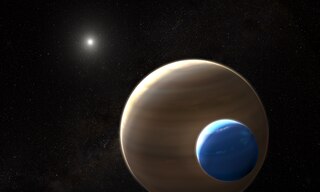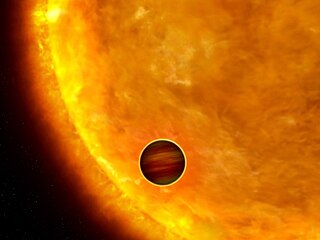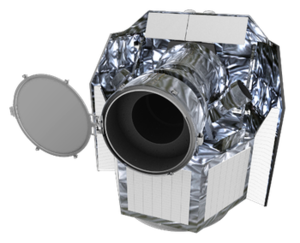
CoRoT was a space telescope mission which operated from 2006 to 2013. The mission's two objectives were to search for extrasolar planets with short orbital periods, particularly those of large terrestrial size, and to perform asteroseismology by measuring solar-like oscillations in stars. The mission was led by the French Space Agency (CNES) in conjunction with the European Space Agency (ESA) and other international partners.

Gaia is a space observatory of the European Space Agency (ESA), launched in 2013 and expected to operate until 2025. The spacecraft is designed for astrometry: measuring the positions, distances and motions of stars with unprecedented precision, and the positions of exoplanets by measuring attributes about the stars they orbit such as their apparent magnitude and color. The mission aims to construct by far the largest and most precise 3D space catalog ever made, totalling approximately 1 billion astronomical objects, mainly stars, but also planets, comets, asteroids and quasars, among others.

An exomoon or extrasolar moon is a natural satellite that orbits an exoplanet or other non-stellar extrasolar body.

Transiting Exoplanet Survey Satellite is a space telescope for NASA's Explorer program, designed to search for exoplanets using the transit method in an area 400 times larger than that covered by the Kepler mission. It was launched on 18 April 2018, atop a Falcon 9 launch vehicle and was placed into a highly elliptical 13.70-day orbit around the Earth. The first light image from TESS was taken on 7 August 2018, and released publicly on 17 September 2018.

CoRoT-1 is a yellow dwarf main sequence star similar to the Sun. The star is located approximately 2,510 light-years away in the constellation of Monoceros. The apparent magnitude of this star is 13.6, which means it is not visible to the naked eye; however, it can be seen through a medium-sized amateur telescope on a clear, dark night. The first exoplanet discovered in the course of the CoRoT mission orbits this star; it is considered to be a "hot Jupiter", and is approximately as massive as the planet Jupiter itself.
HAT-P-7 is a F-type main sequence star located about 1088 light-years away in the constellation Cygnus. The apparent magnitude of this star is 10.5, which means it is not visible to the naked eye but can be seen with a small telescope on a clear dark night.

PLAnetary Transits and Oscillations of stars (PLATO) is a space telescope under development by the European Space Agency for launch in 2026. The mission goals are to search for planetary transits across up to one million stars, and to discover and characterize rocky extrasolar planets around yellow dwarf stars, subgiant stars, and red dwarf stars. The emphasis of the mission is on Earth-like planets in the habitable zone around Sun-like stars where water can exist in a liquid state. It is the third medium-class mission in ESA's Cosmic Vision programme and is named after the influential Greek philosopher Plato. A secondary objective of the mission is to study stellar oscillations or seismic activity in stars to measure stellar masses and evolution and enable the precise characterization of the planet host star, including its age.

An exoplanet is a planet located outside the Solar System. The first evidence of an exoplanet was noted as early as 1917, but was not recognized as such until 2016; no planet discovery has yet come from that evidence. What turned out to be the first detection of an exoplanet was published among a list of possible candidates in 1988, though not confirmed until 2003. The first confirmed detection came in 1992, with the discovery of terrestrial-mass planets orbiting the pulsar PSR B1257+12. The first confirmation of an exoplanet orbiting a main-sequence star was made in 1995, when a giant planet was found in a four-day orbit around the nearby star 51 Pegasi. Some exoplanets have been imaged directly by telescopes, but the vast majority have been detected through indirect methods, such as the transit method and the radial-velocity method. As of 1 April 2024, there are 5,653 confirmed exoplanets in 4,161 planetary systems, with 896 systems having more than one planet. This is a list of the most notable discoveries.
K2-138b is a potentially rocky Super-Earth exoplanet orbiting every 2 days around a K1V star. The planet, along with the four others in the system, was found by citizen scientists of the Exoplanet Explorers project on Zooniverse. It was the final planet found in the system and was officially announced on January 8, 2018.

K2-138, also designated EPIC 245950175 or EE-1, is a large early K-type main sequence star with a system of at least 6 planets discovered by citizen scientists. Four were found in the first two days of the Exoplanet Explorers project on Zooniverse in early April 2017, while two more were revealed in further analysis. The system is about 660 light-years away in the constellation Aquarius, within K2 Campaign 12.

DS Tucanae is a binary star system 144 light years away in the constellation of Tucana. It has an apparent visual magnitude of 8.5, and is a RS Canum Venaticorum variable. The system is notable for being young as a member of the 45 Myr old Tucana-Horologium moving group and for the primary star hosting the confirmed exoplanet DS Tucanae Ab, discovered by THYME, using TESS.
Katherine Gudrun Isaak is a British astrophysicist and the Project Scientist for the European Space Agency Characterising Exoplanet Satellite mission (CHEOPS). She is based at European Space Research and Technology Centre.
WASP-189 b is an extrasolar planet that has an orbital period around its host star, WASP-189, of less than three earth days, and is about 322 light-years away in the Libra constellation. It was first discovered in 2018, and was observed in 2020 by CHEOPS.
HD 108236 is a G-type main-sequence star. Its surface temperature is 5660±61 K. HD 108236 is severely depleted in heavy elements compared to the Sun, with a metallicity Fe/H index of −0.28±0.04, and is probably older than the Sun at an age of 6.7+3.3
−3.4 billion years.
LTT 9779 is a G-type main-sequence star located 264 light-years away from the Solar System in the constellation of Sculptor. The star is about 95% the radius and about the same mass as the Sun, but younger than the Sun at 1.7 billion years old, hence its lower luminosity. It has a temperature of 5,443 K and a rotation period of 45 days. LTT 9779 is orbited by one known exoplanet.













